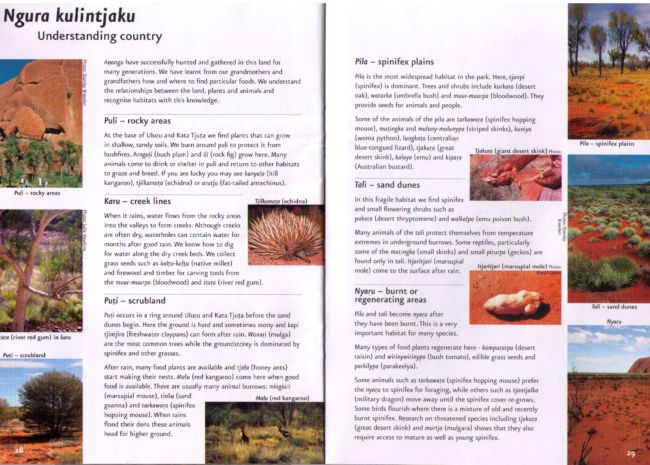Palya! Welcome to Anangu land
When we entered Uluru – Kata Tjuta National Park in the Red Centre of Australia, we were given this awesome guide book of Welcome – Palya – as part of the Park entrance fee ($25 per person). (I believe you now need to collect this from the Cultural Centre – and is available as a pdf download here)
It is a most comprehensive companion to one’s visit offering a myriad of information about Uluru and Kata Tjuta, including their spiritual significance, the walks available, diagrams showing sunset and sunrise viewing areas, basic geology and a glossary of words (with pronunciations) from the traditional owners of Anangu land the Yankunytjatjara and Pitjantjatjara people.
On one page spread it shows and names a breakdown of landscapes seen in the Red Centre.
Entitled Ngura kulintjaku ~ Understanding country.
The Landscapes of the Red Centre
The landscapes of Australia’s red centre are far more varied than I had expected or imagined. One’s initial impression, at first glance, is that of a vast emptiness – This could not be further from the truth.
In understanding the country (ngura kulintjaku) there are five predominant habitats.
Puli ~ Rocky areas, with shallow sandy soil, where wildflowers cling to life
“At the base of Uluru and Kata Tjuta we find plants that can grow in shallow, sandy soils. We burn around puli to protect it from bushfires. Arnguli (bush plum) and ili (rock fig) grow here. Many animals come to drink or shelter in puli and return to other habitats to graze and breed. If you are lucky you may see kanyala (hill kangaroo), tjilkamata (echidnas) or arutju (fat-tailed antechinus).”
Karu ~ Creek lines, where river red gums flourish
“When it rains, water flows from the rocky areas into the valleys to form creeks. Although creeks are often dry, waterholes can contain water for months after good rain. We know how to dig for water along the dry creek beds. We collect grass seeds such as kaltu-kaltu (native millet) and firewood and timber for carving tools from the muur-muupa (bloodwood) and itara (river red gum).”
Puti ~ Scrubland, which occurs in a ring around Uluru
“Puti occurs in a ring around Uluru and Kata Tjuta before the sand dunes begin. Here the ground is hard and sometimes stony and kapi tjintjira (freshwater claypans) can form after rain. Wanari (mulga) are the most common trees while the ground storey is dominated by spinifex and other grasses.”
Pila ~ The spinifex plains, interspersed with the wind whistling desert oaks
“Pila is the most widespread habitat in the park. Here, tjanpi (spinifex) is dominant. Trees and shrubs include kurara (desert oak), watarka (umbrella bush) and muur-muurpa (bloodwood). They provide seeds for animals and people.”
Tali ~ the sand dunes, where only spinifex and small flowering shrubs can survive.
“Many animals of the tali protect themselves from temperature extremes in underground burrows. Some reptiles, particularly some of the mutingka (small skinks) and small pirurpa (geckos) are found only in tali.”










The Red Centre is a must!
You can have seen it in a million photos, but the reality is a million times better 😉
Ill be going in mid July! So excited!
Brilliant!!
And July will be a lovely time of year weather wise 🙂
Pingback: A Dozen Views from the Car Window... Uluru to Atherton
Pingback: How much does it Cost to Travel from Uluru to Cairns?